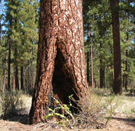A Qualitative Study with the Eastern Band of Cherokee and Southern Appalachian Community Members
Nicolette Cooley. 2004. Understanding Traditional Knowledge for Ecological Restoration: A Qualitative Study with the Eastern Band of Cherokee and Southern Appalachian Community Members. Masters Thesis, NAU School of Forestry.
Full text [here]
Selected excerpts:
Abstract
The primary objective of the research project, Understanding Traditional Knowledge for Ecological Restoration: A Qualitative Interview Study with Cherokee and Southern Appalachian Community Members, in North Carolina was to gather data concerning historical land management practices exemplified by traditional ecological knowledge and practices of the Cherokee Nation, specifically burning. This particular research project was established due to a collaborative effort between the Ecological Restoration Institute (ERI) at Northern Arizona University (NAU) and Coweeta Hydrological Laboratory in Otto, North Carolina. The study was designed to collect information about the fire history of the Southeast focusing on the region historically and currently occupied by the Eastern Band of Cherokee Indians (E.B.C.I) within a two year time frame.
Introduction
The use of traditional ecological knowledge (TEK) of fire has been debated since the mid sixteenth century (Goodwin 1977) when non-Native American people viewed Indians as not being civilized enough to know the uses and effects of fire. This view brought about the belief that the Indians could not have had any significant influence on the environment (Kretch III 1999). The arrival of European explorers and settlers brought on a number of changes for the Indians and the land they occupied. Indians have brought on a number of changes for the Indians and the land they occupied. Indians have used fire to clear land for agriculture, improve visibility for hunting and traveling, and reduce the accumulation of fuels to prevent catastrophic wildfires (Noss 1983). Particularly in the Southern Appalachians Native Americans have been burning for agricultural and hunting purposes for 10,000 years (Keel 1976 in Van Lear and Waldrop 1989). Instead of acting as a destructive force, the Indians were acting as a functioning component of the ecosystem (Goodwin 1977). As a functioning component in the ecosystem, Native Americans were intentionally burning and cutting trees down because they knew burning and cutting created specific effects. For example, Goodwin describes how Indians burned forests to prevent uncontrolled fires, to clear heavy fuel loads, and undesirable weeds for cultivation. He goes on to discuss how Indians burned longleaf pine (Pinus palustrus) forests to eliminate brown-spot needle disease and competitive vegetation. Goodwin describes the importance of longleaf pine to build shelter, build canoes, and for firewood.
The Benefits of Forest Restoration
Mike Dubrasich. 2010. The Benefits of Forest Restoration. W.I.S.E. White Paper 2010-2. Western Institute for Study of the Environment.
Full text [here]
Restoration forestry aims to recover our nation’s forest heritage while also restoring the productive and harmonious relationship between people and forests that existed in historic forests. Restoration forestry is a vision for the future rooted in respect for the past. — Dr. Thomas M. Bonnicksen, Protecting Communities and Saving Forests–Solving the Wildfire Crisis Through Restoration Forestry.
FOREST restoration means active management to bring back historical cultural landscapes, historical forest development pathways, and traditional ecological stewardship to achieve historical resiliency to fire and insects and to preclude and prevent a-historical catastrophic fires that decimate and destroy myriad resource values.
Forest restoration is beneficial to man and nature in numerous ways. The following describes these benefits in general.
1. Heritage and history
To restore means to return to a former or original state. In the case of forests, restoration requires knowledge of and respect for forest history as a starting point. Forest restoration looks to pre-Contact forest conditions as a guideline.
Many (if not most) North American forests were at one time (prior to ~120 years ago) open and park-like, with widely spaced, large, old trees. Forests were conditioned to be that way by frequent, non-stand-replacing, anthropogenic fires. Historical human features included village sites; sacred and ceremonial sites; hunting, gathering, agricultural and proto-agricultural fields; extensive trail networks; prairies and savannas; and other features induced and maintained by ancient human tending through the use of traditional ecological knowledge.
Forest restoration, properly researched, designed, and implemented, restores, protects, and perpetuates many of the heritage features of forested landscapes.
